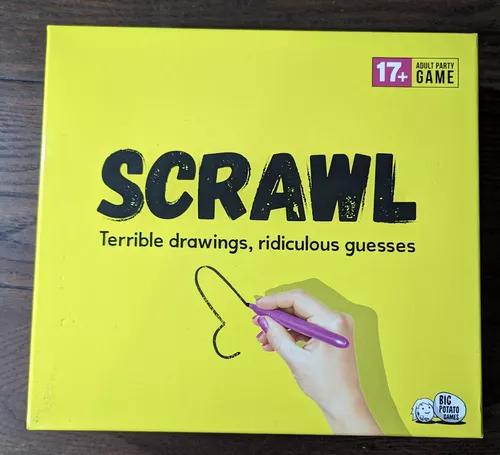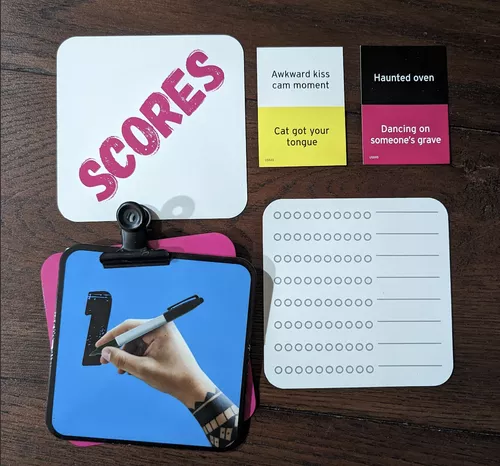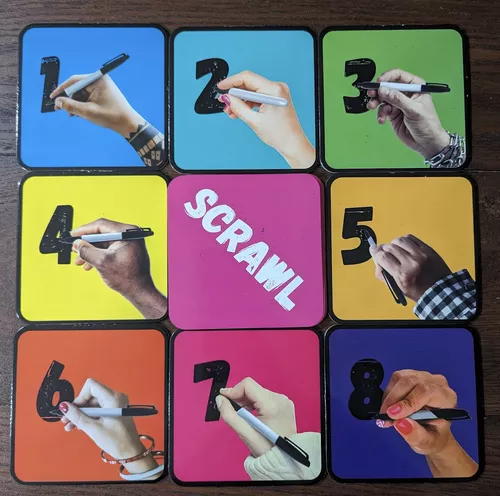Scrawl Board Game Review: a Drawing Game of Miscommunication
- Coty

- Dec 30, 2023
- 3 min read
Introduction
About six years ago, a friend gave me Scrawl as a birthday gift. The game was an instant hit and the same eight of us would play this game on a monthly basis. Most of us lacked artistic abilities, and a few of us had them (which I did not). It was the perfect combination for those who could draw versus those with barely any stick-figure drawing abilities.
Gameplay and Replayability
The game has four options on each card, ensuring high replayability. I am not certain if a colored side is harder than the others. Some cards come easily, and some make you scratch your head. Each game we pick a color, and cards that don’t inspire anyone or were drawn in a previous game are discarded. To avoid analysis paralysis, we set a timer for a minute and assess everyone's progress. This usually gives us enough time to create our masterpieces. Then, you grab a clip and a clean sheet, passing your masterpiece to the next player.
The Fun Cycle ✍️
The next person writes down their interpretation, clips a new sheet, and passes it on again. This cycle of drawing, writing, and passing continues until your original card returns to you. This is where the fun begins!
Scoring and Game End
We take turns revealing the original prompt, followed by the first drawing and interpretation. Then, we work through the subsequent interpretations and drawings. Each player awards one point for the best drawing or most inspired interpretation. In the unlikely event that a drawing or interpretation closely matches your original card, three bonus points are awarded to that player.
The game ends when a player reaches two points more than the number of players. However, because accurate guesses are rarely earned, and depending on the games we’ve planned to play, we've adapted our sessions to either one round per player or first to five points.
Additionally, we pass the cards in a different direction after each turn, allowing us to draw and write prompts for different players throughout the game.
Game Components and Durability
240 4-sided prompt cards, 8 dry erase markers, 8 dry erase sheets made out of cloth, dry erase sheets, 8 clips, 8 player boards, 2 score sheets, and a well-written rulebook.
Scrawl is incredibly simple to learn and play. Big Potato Games excels at straightforward rule books, and their YouTube video teaches the game in under three minutes.
The components are durable and dry-erase, a feature that spoiled me for other games. I now blame this game for my need to laminate and use dry-erase markers for all my roll/flip and write games! We've only lost two markers that won’t write anymore and a few sheets that became too dirty after countless uses. The game stores neatly in its organizer. I am not sure if this has changed since my print as Big Potato Games has become plastic-free. Our organizer keeps the game components neatly and ready for the next game. The only minor improvement I could suggest is for the eraser sheets, but that’s because I like actual erasers
What Makes Scrawl Stand Out
The unexpected laughter while revealing each card. Surprisingly, the prompts are sometimes funnier than the drawings themselves.
PROS
- Dry-erase game!
- Fast-paced
- Laughter and good times guaranteed
- Easy to learn and play
- Perfect for parties
CONS
- Not suitable for children or those sensitive to inappropriate language
- Not language-independent
Conclusion
Scrawl is a game that will probably never leave my collection. After six years, our gaming palette has evolved. We've moved to upstate New York, yet we continue to enjoy this game. Even though the game doesn’t get played as frequently as it used to, it still finds its place at our table. The game serves us more as a filler game than the main event, but it still remains as fresh as the first time.








Comments